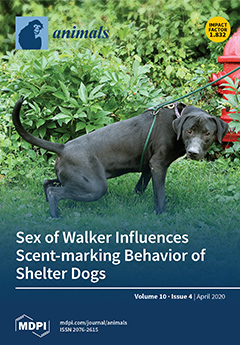In a pilot study, simultaneous infection with
Chlamydia psittaci (
C. psittaci) and H9N2 virus induced 20% mortality and severe avian airsacculitis, shedding light on animal models of poultry respiratory diseases. However, the pathogenesis is still unclear. In the current study, we
[...] Read more.
In a pilot study, simultaneous infection with
Chlamydia psittaci (
C. psittaci) and H9N2 virus induced 20% mortality and severe avian airsacculitis, shedding light on animal models of poultry respiratory diseases. However, the pathogenesis is still unclear. In the current study, we hypothesized that
C. psittaci infection execrates macrophage function and facilitates H9N2 infection. To explore the potential mechanism, we studied the effect of
C. psittaci and H9N2 on the functions of HD11 cells in vitro by simultaneous infection of
C. psittaci and H9N2. At the same time, we used infection with
C. psittaci or H9N2 alone as the control groups. The results showed that coinfection with
C. psittaci and H9N2 could significantly aggravate the mortality of HD11 cells compared to
C. psittaci or H9N2 infection alone. In addition, coinfection with
C. psittaci and H9N2 did not induce high
C. psittaci loads compared to
C. psittaci infection alone at 12- and 24-hours post-inoculation (hpi), but coinfection with
C. psittaci and H9N2 could increase the loads of H9N2 compared to H9N2 alone in HD11 cells at 12 hpi. More importantly, inducible nitric oxide synthase (iNOS) expression levels, enzyme activity, nitric oxide (NO) production, and phagocytosis were reduced significantly in the group with
C. psittaci and H9N2 coinfection compared to those of H9N2 or
C. psittaci alone at 24 hpi. Finally,
C. psittaci infection induced robust expressions of type Th2 cytokines interleukin (IL)-4 and IL-10, while interferon gamma (IFN-γ) and tumor necrosis factor-α (TNF-α) displayed a significant decrease compared to H9N2 infection alone at 24 hpi. All the above data indicate that
C. psittaci infection can facilitate H9N2 invasion and to aggravate severe avian airsacculitis by impairing macrophage functions.
Full article


